 | –≠–ª–µ–∫—Ç—Ä–æ–Ω–Ω—ã–π –∫–æ–º–ø–æ–Ω–µ–Ω—Ç: LU5X31F | –°–∫–∞—á–∞—Ç—å:  PDF PDF  ZIP ZIP |
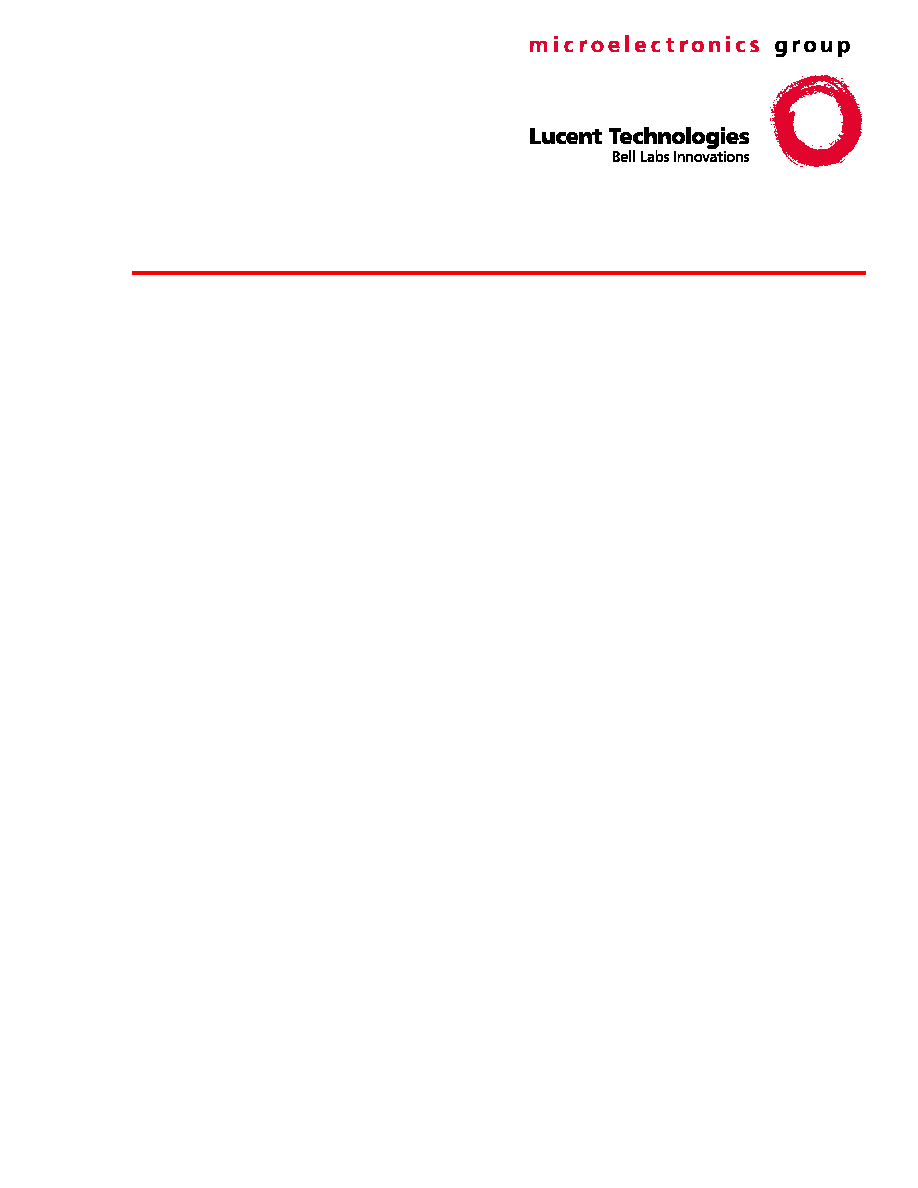
Preliminary Data Sheet
August 2000
LU5X31F
Gigabit Ethernet Transceiver
Overview
The LU5X31F is a low-cost, low-power gigabit Ether-
net transceiver. It is used for data transmission over
fiber or coaxial media in conformance with
IEEE*
802.3z Gigabit Ethernet specification and Fibre
Channel
ANSI
X3T11 at 1.0 Gbit/s and
1.25 Gbits/s.
The transmitter section accepts parallel 10-bit, 8b/
10b encoded data that is latched on the rising edge
of REFCLK. It also uses this clock to synthesize the
internal high-speed serial bit clock. The serialized
data is then available at the differential PECL out-
puts, terminated in 50
or 75
to drive either an
optical transmitter or coaxial media.
The receive section receives high-speed serial data
at its differential PECL input port. This data is fed to
the digital clock recovery section, which generates a
recovered clock and retimes the data. The retimed
data is deserialized and presented as 10-bit parallel
data on the output port. A divided-down version of
the recovered clock, synchronous with parallel data
bytes, is also available as a TTL compatible output.
The receive section recognizes the comma character
and aligns the comma containing byte on the word
boundary, when ENCDET = 1.
*
IEEE
is a registered trademark of The Institute of Electrical and
Electronics Engineers, Inc.
ANSI
is a registered trademark of American National Standards
Institute.
FireWire
is a registered trademark of Apple Computer, Inc.
Features
s
Designed to operate in Ethernet, fibre channel,
FireWire
,
or backplane applications.
s
Operationally compliant to
IEEE
802.3z Gigabit
Ethernet specification.
s
Operationally compliant to Fibre Channel
ANSI
X3T11. Provides FC-0 services at 1.0 Gbit/s--
1.25 Gbits/s (10-bit encoded data rate).
s
100 MHz--125 MHz differential or single-ended
reference clock.
s
10-bit parallel interface.
s
8b/10b encoded data.
s
High-speed comma character recognition (K28.1,
K28.5, K28.7) for latency-sensitive applications
and alignment to word boundary.
s
Two 62.5 MHz receive-byte clocks.
s
Single-analog PLL design requires no external
components for the frequency synthesizer.
s
Novel digital data lock in receiver avoids the need
for multiple analog PLLs.
s
Expandable beyond single-channel SERDES.
s
PECL high-speed interface I/O for use with optical
transceiver or coaxial copper media.
s
Requires one external resistor for PECL output ref-
erence level definition.
s
Available in both 64-pin MQFP (14 mm) and 64-pin
TQFP (10 mm) packages.
s
Low-power digital 0.25 µm CMOS technology.
s
3.3 V ± 5% power supply.
s
0 ∞C--70 ∞C ambient temperature.

2
Table of Contents
Lucent Technologies Inc.
Contents
Page
Figure
Page
LU5X31F
Preliminary Data Sheet
Gigabit Ethernet Transceiver
August 2000
Overview ................................................................. 1
Features .................................................................. 1
Functional Description ............................................ 3
Transmitter Section .............................................. 3
Receiver Section .................................................. 3
Byte Alignment ..................................................... 4
Parallel Output Port .............................................. 4
Loopback Mode Operation ................................... 4
Powerup Sequence .............................................. 5
Device Reset ........................................................ 5
Block Diagram ...................................................... 6
Input/Output Information ......................................... 7
Electrical Specifications ........................................ 10
Transmitter ......................................................... 10
Receiver ............................................................. 11
Timing Characteristics .......................................... 12
Serial Timing ...................................................... 12
Receiver Section Timing .................................... 13
Receiver Port Timing .......................................... 13
Transmitter Section Timing ................................ 14
Application Section ............................................... 15
Test Modes ........................................................... 17
Outline Diagrams .................................................. 19
64-Pin MQFP ..................................................... 19
64-Pin TQFP ...................................................... 20
Ordering Information ............................................. 21
Table
Page
Table 1. Definition of Bit Transmission/Reception
Order ......................................................................4
Table 2a. I/O Channel Signal Description .................8
Table 2b. I/O Control/PLL Interface Descriptions .....9
Table 2c. Power Connections ...................................9
Table 3. Reference Clock Specifications (REFCLK) 10
Table 4. PLL Characteristics ...................................10
Table 5. Output Jitter at 1.0 Gbit/s--1.25 Gbits/s Data
Rate ......................................................................10
Table 6. Input Data Rate .........................................11
Table 7. Data Lock Characteristics .........................11
Table 8. Power Dissipation* ....................................11
Table 9. dc Electrical Specifications* ......................11
Table 10. Absolute Maximum Ratings ....................11
Table 11. Serial Output Timing Levels ....................12
Table 12. Serial Input Interface Timing ...................12
Table 13. Receiver Parallel Port Timing .................13
Table 14. Transmitter Timing at Parallel Interface ..14
Table 15. External Resistor Value vs. Differential Output
Level Viewing .......................................................16
Table 16. Test Modes .............................................17
Figure 1. LU5X31F Single-Channel Gigabit Ethernet
Transceiver Functional Diagram .......................... 6
Figure 2. 64-Pin MQFP Package (14 mm) Pinout .. 7
Figure 3. Serial Interface Timing ........................... 12
Figure 4. Receiver Section Timing ........................ 13
Figure 5. Receiver Port Timing ............................. 13
Figure 6. Parallel Interface Transmit Timing ......... 14
Figure 7. Reference Clock Connections with Single-
Ended Source ..................................................... 15
Figure 8. Typical Termination for a Single-Channel,
High-Speed Serial Transmit-and-Receive Port in a
50
Backplane Application ............................... 15
Figure 9. Typical Termination for a Single-Channel,
High-Speed Serial Transmit Port Interfacing a 5 V
GBIC Transceiver ............................................... 16

3
Lucent Technologies Inc.
Preliminary Data Sheet
LU5X31F
August 2000
Gigabit Ethernet Transceiver
Functional Description
The LU5X31F transceiver provides for data transmis-
sion over fiber or coaxial media at 1.0 Gbits/s to
1.25 Gbits/s. The block diagram of a single channel is
shown in Figure 1. The input/output designations are
given in Table 3.
Transmitter Section
The transmitter accepts 8B/10B encoded bits in 10-bit
parallel form and converts to serial format for up
to 1.25 Gbits/s transmission. The serial nonreturn to
zero (NRZ) bits are shifted out of the device at a maxi-
mum rate of 1.25 Gbits/s. Internally, the device uses
two parallel shift registers that operate at half rate (i.e.,
a maximum of 625 MHz) for reduced power consump-
tion. The two shift registers drive the PECL output
buffer in an interleaved manner to construct the
1.25 Gbits/s output data stream.
The typical transmit and receive high-speed I/O inter-
facing is shown in Figures 8 and 9, for a single-channel
application.
The transmit shift register and other circuits are driven
with clocks generated from a 500 MHz--625 MHz inter-
nal clock. This internal clock is sourced from a voltage-
controlled oscillator (VCO) that is locked to the external
reference of 100 MHz--125 MHz. The internal transmit
phase-lock loop multiplies the frequency of the input
reference clock by a factor of 5, and controls the trans-
mit jitter bandwidth with appropriate design of the jitter
transfer function. The transmit phase-lock loop gener-
ates multiple clock phases that are all used by each of
the four receiver circuits. The clock phases are derived
from the transmit VCO.
Receiver Section
The receiver circuit extracts the clock from, and
retimes, the serial input data. The data is input to the
receiver on differential PECL buffers. External termina-
tion resistors are supplied by the user in accordance
with
ANSI
standard, X3T11. The serial differential
inputs, HDINP and HDINN, are ac-coupled to the
device and internally biased to the PECL input com-
mon-mode range center. See Figures 8 and 9 for the
typical termination of the transmission lines.
The receiver data retiming circuit uses a digital timing
recovery loop that compares the phase of the input
data to multiple phases of the on-device VCO in the
transmit section. One of the phases is chosen to retime
the receive data. A digital low-pass filter is used in the
timing recovery loop to reject jitter from the data input.
A novel phase interpolation circuit permits the retiming
clock's phase to be stepped with fine resolution for pre-
cise alignment of the sampling clock within the data
eye. Use of this digital data locking scheme avoids the
use of multiple analog phase-lock loops on-device that
can potentially injection lock to one another when
expanded to multiple receivers. Additionally, the digital
data locking loop maintains precise loop dynamics,
hence, the jitter transfer function is process and tem-
perature independent.

4
4
Lucent Technologies Inc.
LU5X31F
Preliminary Data Sheet
Gigabit Ethernet Transceiver
August 2000
Functional Description
(continued)
Byte Alignment
When ENCDET = 1, the LU5X31F recognizes the
comma character and aligns this 10-bit character to the
word boundary, bits RX[0:9].
COMDET = 1 when the parallel output word contains a
byte-aligned comma character. The COMDET flag will
continue to pulse a logic 1 whenever a byte-aligned
comma character is at the parallel output port, indepen-
dent of ENCDET. When ENCDET = 0 there are two pos-
sible scenarios, depending upon when the comma
character is received:
1. If byte alignment had been previously achieved when
ENCDET had been a logic 1, the COMDET flag will
continue to pulse a logic 1 whenever a byte-aligned
comma character is at the parallel output port. If a
comma character occurs that is not on the word
boundary, no attempt will be made to align this
comma character, and the COMDET flag will remain
at a logic 0.
2. If byte alignment had not been previously achieved
when ENCDET had been a logic 1, then the first (and
only the first) comma character received will be
aligned to the word boundary. COMDET will pulse
when the comma character is aligned to the word
boundary.
Parallel Output Port
Timing for the parallel output data and the 62.5 MHz
receive-byte clock is given in Table 14.
Two low data-rate, receive-byte clocks are available as
outputs during use of the parallel output port in 10-bit
mode. RXCLK1 is the receive-byte clock used by the
protocol device to register bytes 0 and 2. RXCLK0 is
the receive-byte clock used by the protocol device to
register bytes 1 and 3, and it is 180 degrees out of
phase with RXCLK1. Both RXCLK1 and RXCLK0 can
be stretched during byte alignment, but not truncated
or slivered. The maximum allowable frequency of these
two clocks under all circumstances, excluding start-up,
will not exceed 80 MHz. The start-up time is specified
as 1 ms.
Loopback Mode Operation
A control signal input, EWRAP, selects between two
possible sets of inputs: normal data (HDINP, HDINN),
or internal loopback data. When EWRAP = 1, the serial
output ports, HDOUTP and HDOUTN, remain active.
The serial transmit data prior to the PECL output driver
is directed to the data recovery circuit, where the clock
is recovered and data is resynchronized to the recov-
ered clock. Retimed data and clock then go to the
serial-to-parallel converter.
Table 1. Definition of Bit Transmission/Reception Order
Serial Transmit/
Receive Rate
TX[9:0]
RX[9:0]
1.0 Gbits/s to 1.25 Gbits/s TX[0] bit serially transmitted first at
HDOUTP, HDOUTN.
RX[0] bit received first at serial inputs,
HDINP, HDINN.

5
Lucent Technologies Inc.
Preliminary Data Sheet
LU5X31F
August 2000
Gigabit Ethernet Transceiver
Functional Description
(continued)
Powerup Sequence
The power ramp time for the LU5X31F is specified at
V
DD
> 2.7 V within 20 µs of start-up. Once 2.7 V is
reached, the device is held in reset for 15 µs--
70 µs. The REFCLK must be active and within specifi-
cation at this point and remain active while the device
is powered up, unless in reset.
When signals RESETN, BYPPLL, and LPWR are all
low, the following start-up sequence occurs:
1. 0 µs--32 µs, the analog PLL is held at minimum fre-
quency to allow dc bias to settle.
2. 32 µs--262 µs, the analog PLL has locked in and
receiver analog circuits start to lock in.
3. 262 µs--326 µs, the receiver analog circuits are
locked; receiver starts to lock onto incoming data.
4. After 358 µs, the receiver is locked onto incoming
data and can be viewed at the parallel output ports.
The comma-detect circuit is enabled at this point,
allowing byte alignment if ENCDET = 1.
Device Reset
The RESETN input to the device is an active-low.
When activated with a pulse duration of 1 µs, the
RESETN signal globally resets the device and the fol-
lowing is performed:
1. The single analog PLL is forced to operate at the
minimum frequency possible for its VCO. The PLL
will not be locked in this condition.
2. The HDOUTP, HDOUTN outputs are forced to a
PECL logic 0.
3. The deserializer clocks are reset, input data at
HDINP, HDINN is ignored, and the RX[9:0] signals
remain in their previous state.
4. The phase interpolation/selection circuits are deacti-
vated and the selected phase is reset.
5. The receiver digital low-pass filter in the DPLL is
reset. Normally, a reset is not necessary for correct
operation, although a reset can aid rapid lock-in of
the internal PLL circuitry. This signal is internally
pulled high.
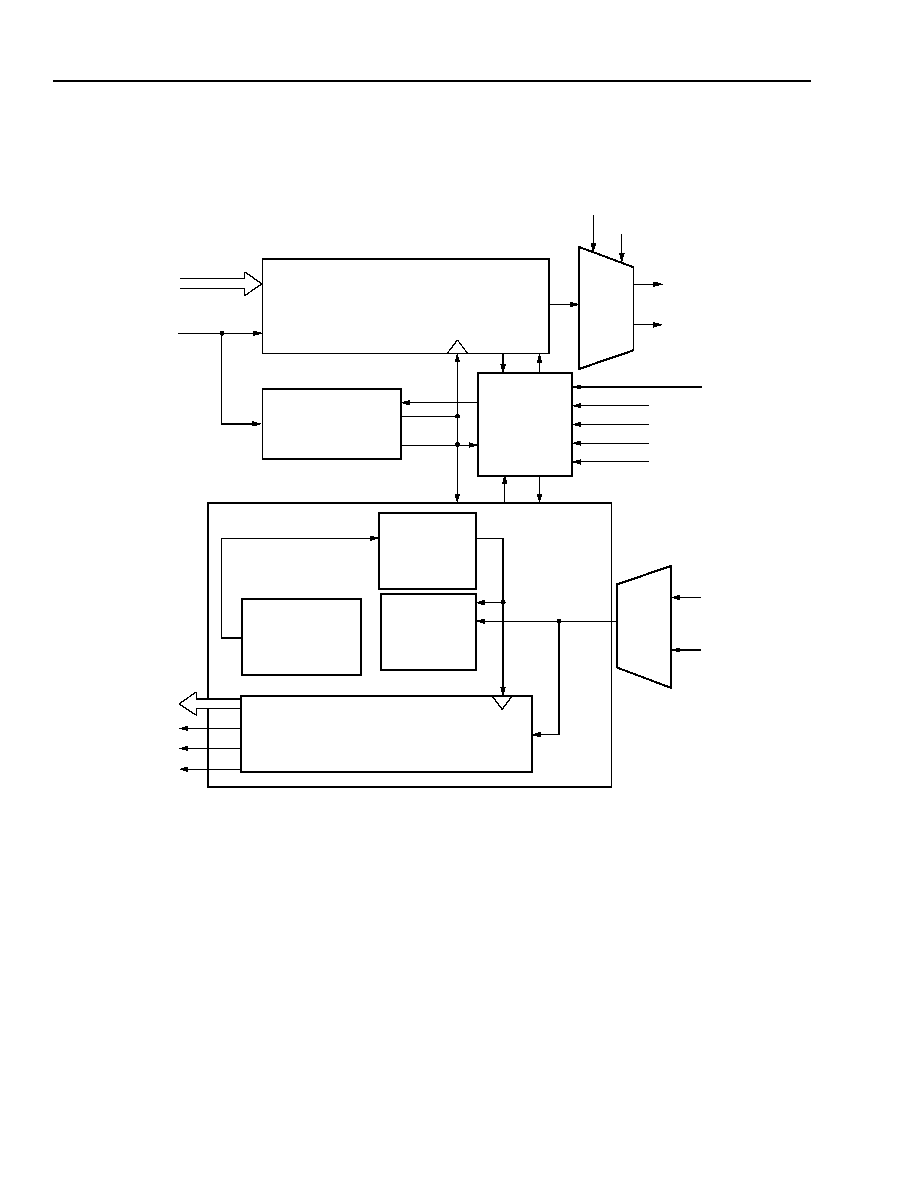
6
Lucent Technologies Inc.
LU5X31F
Preliminary Data Sheet
Gigabit Ethernet Transceiver
August 2000
Functional Description
(continued)
Block Diagram
Figure 1. LU5X31F Single-Channel Gigabit Ethernet Transceiver Functional Diagram
DATA IN
LOAD
SERIALIZER
SERIAL DATA
OUT
PECL
HDOUTP
HDOUTN
TEST[5:1]/LDST
BYPPLL
RESETN
EWRAP
HDINP
HDINN
PECL
GLOBAL
CONTROL
PHASE SELECT/
DESERIALIZER
ANALOG PLL
TX[9:0]
REFCLK
RX[9:0]
RXCLK0
RXCLK1
DATA RETIMING, SERIAL TO PARALLEL
CONVERSION, AND COMMA DETECTION
SERIAL
DATA
IN
LOW-PASS FILTER
DIGITAL
PHASE
DETECTOR
COMDET
ENCDET
OLREF
OLRVS
INTERPOLATION

7
Lucent Technologies Inc.
Preliminary Data Sheet
LU5X31F
August 2000
Gigabit Ethernet Transceiver
Input/Output Information
Figure 2. 64-Pin MQFP Package (14 mm) Pinout
30
28
27
26
25
24
23
22
21
20
29
VD
D
NC/T
EST
4
NC/T
EST
2
EW
R
A
P
VSS
VD
D
RX
CL
K
0
VSS
31 32
19
18
17
RE
F
C
L
K
NC/RES
E
T
N
VD
D
VD
D
VD
D
RX
CL
K
1
VSS
EN
CDET
14
12
11
10
9
8
7
6
5
4
13
TX4
TX7
VSS/TEST3
TX1
VDD
TX9
VSS/BYPPLL
TX6
15
16
3
2
1
TX3
VDD/TEST5
TX0
TX2
TX8
VSS
NC/TEST1
TX5
VDD
RX6
OLRVS
VSS
RX1
RX7
RX9
RX4
RX2
RX5
COMDET
RX0
VDD
RX8
VSS
RX3
35
37
38
39
40
41
42
43
44
45
36
34
33
46
47
48
51
53
54
55
56
57
58
59
60
61
52
VSS
T
HDINP
VSS
HDOUT
P
VDDT
HDINN
VDDP
VSS
R
50 49
62
63
64
VDDT
VDDR
VDD
HDOUT
N
VDDR
VSS
P
OL
RE
F
VDDR
5-8869(F)

8
Lucent Technologies Inc.
LU5X31F
Preliminary Data Sheet
Gigabit Ethernet Transceiver
August 2000
Input/Output Information
(continued)
Table 2a. I/O Channel Signal Description
PIN
Name
I/O
Level
Description
2--4,
6--9,
11--13
TX[9:0]
Input
TTL/
CMOS
Transmit Data. One 10-bit, parallel 8b/10b encoded
data byte clocked in on the rising edge of REFCLK.
TX0 is the leading LSB.
34--36,
38--41,
43--45
RX[9:0]
Output
TTL/
CMOS
Receive Data. One 10-bit parallel 8b/10b encoded
data byte clocked out on the alternate rising edges of
RXCLK0, RXCLK1. RX0 is the leading LSB. Any
receive code-group containing a comma character is
clocked by the RXCLK1.
22
REFCLK
Input
TTL/
CMOS
Reference Clock. This 100 MHz--125 MHz clock is
used to latch TX[9:0] data into the LU5X31F for trans-
mission and is used by the transmitter PLL to generate
the 1.0 Gbits/s--1.25 Gbits/s serial data. REFCLK has
a ±100 ppm tolerance requirement.
31
RXCLK0
Output
TTL/
CMOS
Receive Clock 0. 62.5 MHz used to latch odd-num-
bered code-groups in the receive data stream. This
clock may be stretched during code-group alignment,
but should not be truncated or slivered.
30
RXCLK1
Output
TTL/
CMOS
Receive Clock 1. 62.5 MHz used to latch even-num-
bered code-groups in the receive data stream. This
clock may be stretched during code-group alignment
but should not be truncated or slivered. RXCLK1 is
180 degrees out of phase with RXCLK0. Note that the
comma pattern (contained in groups K28.1, K28.5,
K28.7) is constrained to only appear in even-numbered
code-group positions.
62
HDOUTP
Output
PECL
Transmit Data. Positive differential PECL serialized
transmit data at 1.25 Gbits/s; requires external trans-
mission line termination, as given in Figure 8.
61
HDOUTN
Output
PECL
Transmit Data. Negative differential PECL serialized
transmit data at 1.25 Gbits/s; requires external trans-
mission line termination, as given in Figure 8.
54
HDINP
Input
PECL
Receive Data. Positive differential PECL serialized
receive data at 1.25 Gbits/s; requires external transmis-
sion line termination, as given in Figure 8.
52
HDINN
Input
PECL
Receive Data. Negative differential PECL serialized
receive data at 1.25 Gbits/s; requires external transmis-
sion line termination, as given in Figure 8.
47
COMDET
Output
TTL/
CMOS
Comma Detect. Asserted high for a full RXCLK1 cycle
to indicate that a comma code-word is present on
RX[9:0].
24
ENCDET
Input
TTL/
CMOS
Enable Comma Detect. Enables COMDET and code-
word synchronization when set high. When low, dis-
ables COMDET and maintains current code-word
alignment.
19
EWRAP
Input
TTL/
CMOS
Enable Wrap. Enables the LU5X31F to internally loop
serialized transmit data to the deserializer. HDOUTP
and HDOUTN outputs remain active.

9
Lucent Technologies Inc.
Preliminary Data Sheet
LU5X31F
August 2000
Gigabit Ethernet Transceiver
Input/Output Information
(continued)
Table 2b. I/O Control/PLL Interface Descriptions
Table 2c. Power Connections
Pin
Name
I/O
Level
Description
49
OLREF
Input/Output
Analog
Output Level Reference. PECL level set resistor
terminal 1.
48
OLRVS
Input/Output
Analog
Output Level Ground. PECL level set resistor
terminal 2.
26
(NC)/
RESETN
Input
TTL/CMOS
RESETN. Active-low, internally pulled high.
10
TEST5
Input/Output
TTL/CMOS
Global Test Control Input/Output.
1, 16, 17, 27
(NC)/
TEST[4:1]
Input
TTL/CMOS
Factory Test Pins. Internally pulled low.
15
BYPPLL
Input
TTL/CMOS
Test Control-PLL Bypass Mode.
Pin
Name
Description
5, 10, 18, 20, 23, 28, 29, 37, 42, 63
V
DD
Digital Power.
53, 55, 57
V
DD
R
High-Speed Receive Analog Power.
59, 60
V
DD
T
High-Speed Transmit Analog Power.
50
V
DD
P
PLL Power.
1, 14, 15, 21, 25, 32, 33, 46, 64
V
SS
Digital Ground.
56
V
SS
R
High-Speed Receive Analog Ground.
58
V
SS
T
High-Speed Transmit Analog Ground.
51
V
SS
P
PLL Ground.

10
Lucent Technologies Inc.
LU5X31F
Preliminary Data Sheet
Gigabit Ethernet Transceiver
August 2000
Electrical Specifications
Transmitter
Table 3. Reference Clock Specifications (REFCLK)
* Measured at 50% amplitude point.
Table 4. PLL Characteristics
Table 5. Output Jitter
at 1.0 Gbit/s--1.25 Gbits/s Data Rate
Parameter
Min
Max
Unit
Frequency Range
100
125
MHz
Frequency Tolerance
≠100
100
ppm
Duty Cycle*
40
60
%
Rise Time (PECL)
--
0.8
ns
Fall Time (PECL)
--
0.8
ns
Rise Time (TTL/CMOS)
--
1.5
ns
Fall Time (TTL/CMOS)
--
1.5
ns
In-band Jitter 1 Gbit/s--1.25 Gbits/s
--
30
ps p-p
Out-of-Band Jitter
--
50
ps p-p
Parameter
Min
Typ
Max
Unit
Bandwidth
--
1.5 --
MHz
Jitter Peaking
--
0.5
--
dB
Lock Time
--
--
230
µs
Parameter
Min
Max
Unit
Deterministic
--
0.08
UI p-p
Random
--
0.12
UI p-p
Total
--
0.2
UI p-p

11
Lucent Technologies Inc.
Preliminary Data Sheet
LU5X31F
August 2000
Gigabit Ethernet Transceiver
Electrical Specifications
(continued)
Receiver
Table 6. Input Data Rate
Table 7. Data Lock Characteristics
*
Data pattern: 111110000 . . .
Data pattern: 101010 . . .
Table 8. Power Dissipation*
* Depending on application (PCB layout, etc.)
Table 9. dc Electrical Specifications*
* Depending on application (PCB layout, etc.).
Table 10. Absolute Maximum Ratings
Parameter
Min
Max
Unit
Frequency Range
1.0
1.25
Gbits/s
Frequency Tolerance with REFCLK
≠100
100
ppm
Parameter
Min
Typ
Max
Unit
Bandwidth 0.3
*
--
1
MHz
Jitter Peaking
--
0.5
--
dB
Lock Time*
--
--
2
µs
Parameter
Min
Max
Unit
Power --
750
mW
Parameter
Symbol
Condition
Min
Typ
Max Unit
Supply Voltage
V
DD
, V
DD
P
--
3.135
3.3
3.465
V
Output Low
V
OL
--
0
--
0.6
V
Output High
V
OH
--
2.4
--
V
DD
V
Input Low
V
IL
--
0
--
0.8
V
Input High
V
IH
--
2.0
--
V
DD
V
Differential PECL
Output
--
Load, as in Figure 8.
800
--
--
mV
Differential PECL
Input
--
Source configuration,
as in Figure 8.
400
--
1600
mV
Parameter
Min Max
Unit
Supply Voltage
3.135
3.465
V
TTL High Input Voltage
3.0
3.6
V
PECL Output Current
--
16
mA
Junction Operating Temperature
0
125
∞C
Storage Temperature
≠65
150
∞C

12
Lucent Technologies Inc.
LU5X31F
Preliminary Data Sheet
Gigabit Ethernet Transceiver
August 2000
Timing Characteristics
Serial Timing
Table 11. Serial Output Timing Levels
Figure 3. Serial Interface Timing
Table 12. Serial Input Interface Timing
Description
Min Typ
Max
Unit
Rise Time 20%--80%
0.17
0.2
0.22
ns
Fall Time 80%--20%
0.17
0.2
0.22
ns
Common Mode
V
DD
/2 ≠ 0.1
V
DD
/2
V
DD
/2 + 0.1
V
Differential Swing
0.8
--
1.6
V p-p
Load (See Table 16.)
50
--
75
Description
Min
Max
Unit
Rise Time (tR)
150
225
ps
Fall Time (t
F
)
150
225
ps
Differential Swing (V
DIFF
)
0.4
1.6
Vp-p
Source Impedance
50
75
Data Eye Opening (D
WIN)
320
--
ps
V
DIFF
D
WIN
tF/tR
5-8813(F)

13
Lucent Technologies Inc.
Preliminary Data Sheet
LU5X31F
August 2000
Gigabit Ethernet Transceiver
Timing Characteristics
(continued)
Receiver Section Timing
Figure 4. Receiver Section Timing
Receiver Port Timing
Figure 5. Receiver Port Timing
Table 13. Receiver Parallel Port Timing
* 1.25 Gbits/s.
0.5 pF load.
Symbol
Parameter
Min
Max
Unit
--
RXCLK[1:0] Frequency*
--
62.5
MHz
--
RXCLK[1:0] Low
7.0
9.0
ns
--
RXCLK[1:0] High
7.0
9.0
ns
tR/F
RXCLK[1:0] (0.4 V to 2.6 V)
0.2
0.5
ns
tR/F
Data Output (0.4 V to 2.6 V)
0.2
0.5
ns
tS
Setup Time
3.0
--
ns
tH
Hold Time
2.0
--
ns
tSKEW
Skew
--
1.0
ns
RX[9:0]
D7.2
HDNIP
RECOVERED CLOCK
RXCLK1
RXCLK0
COMDET
(INTERNAL)
K28.5
K28.5
D7.2
D0.0
D1.0
RXCLK1
RXCLK0
RX
RX0
RX1
RX2
RX3
RXCLK1 HIGH
RXCLK1 LOW
RXCLK PERIOD
tSKEW
tS
tH
tS
tH
5-8813(F)
5-8814(F)

14
Lucent Technologies Inc.
LU5X31F
Preliminary Data Sheet
Gigabit Ethernet Transceiver
August 2000
Timing Characteristics
(continued)
Transmitter Section Timing
Figure 6. Parallel Interface Transmit Timing
Table 14. Transmitter Timing at Parallel Interface
Description
Min
Max
Unit
Conditions
Data Setup
2
--
ns
With Positive Edge REFCLK
Data Hold
1
--
ns
With Positive Edge REFCLK
Rise Time
--
1
ns
--
Fall Time
--
1
ns
--
SYNTHESIZED CLOCK
SERIALIZED DATA
TX[9:0]
REFCLK
155
126
375
34A
155
126
375
5-8811(F).a

15
Lucent Technologies Inc.
Preliminary Data Sheet
LU5X31F
August 2000
Gigabit Ethernet Transceiver
Application Section
Figure 7. Reference Clock Connections with Single-Ended Source
* External resistor connected between OLREF and OLRVS
.
See Table 16 for external resistor value required for differential output swing.
Damping resistor, maximum = 10
.
Figure 8. Typical Termination for a Single-Channel, High-Speed Serial
Transmit-and-Receive Port in a 50
Backplane Application
CLOCK
SOURCE
REFCLK
REFCLKN
BIAS
BIAS
INTERNAL
CLOCK
LU5X31F
5-8811(F).c
HDINP
HDINN
HDOUTP
HDOUTN
0.01
µ
F
10
50
50
100
0.01
µ
F
TRANSMIT
LU5X31F
RECEIVE
RXCLK1
RXCLK0
RX[9:0]
OLREF
OLRVS
TXA[9:0]
REFCLK
10
0.1
µ
F
*
Z
O
= 50
Z
O
= 50
LU5X31F
5-8010(F)
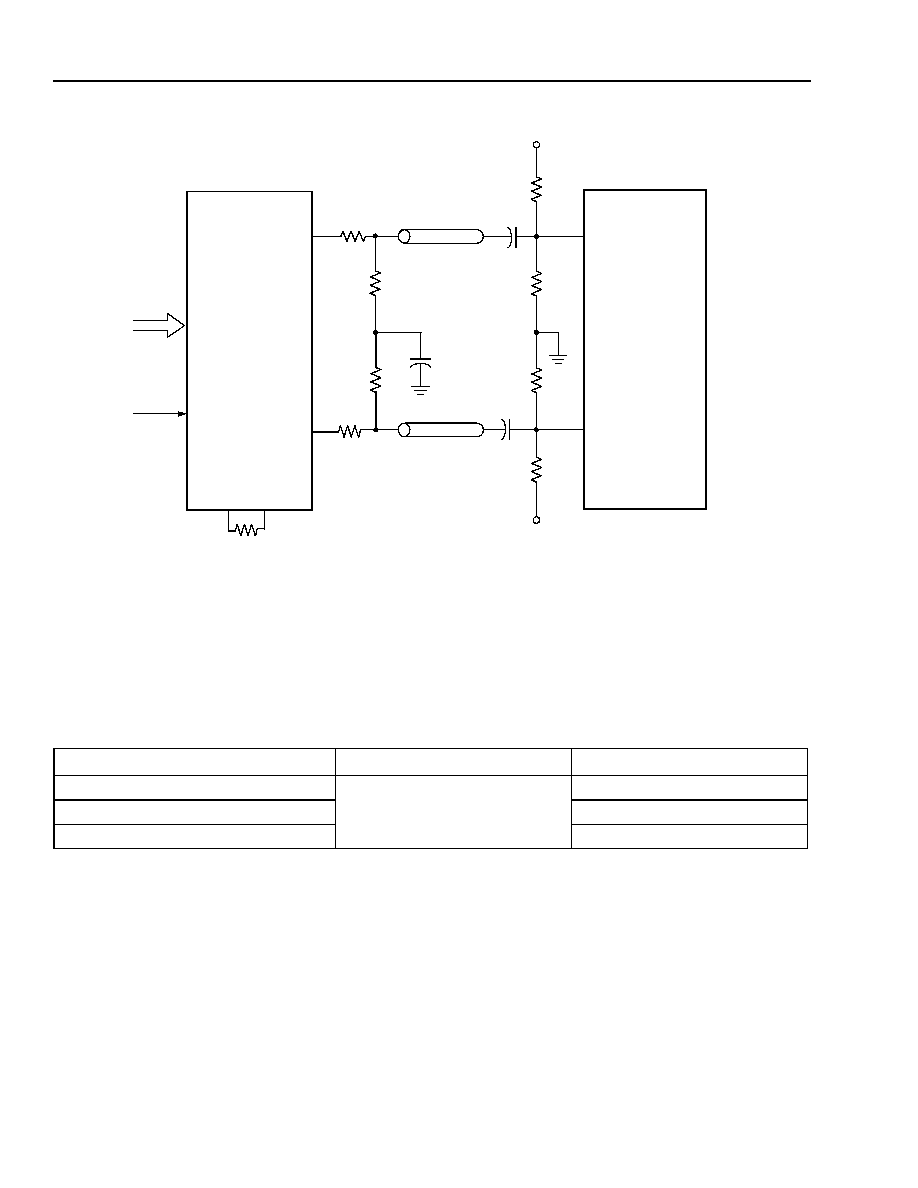
16
Lucent Technologies Inc.
LU5X31F
Preliminary Data Sheet
Gigabit Ethernet Transceiver
August 2000
Application Section
(continued)
* External resistor connected between OLREF and OLRVS
.
See Table 16 for resistor value vs. termination impedance and output swing.
Damping resistor, maximum = 10
.
Figure 9. Typical Termination for a Single-Channel, High-Speed Serial
Transmit Port Interfacing a 5 V GBIC Transceiver
Table 15. External Resistor Value vs. Differential Output Level Viewing
Resistor Value (
)
Termination Impedance (
)
Differential Output Voltage (V)
7.5 K/11.25 K
50/75
0.8
5 K/7.5 K
1.2
4 K/6 K
1.6
5-8811(F)b
TX(+)
TX(≠)
HDOUTP
HDOUTN
0.01
µ
F
10
50
50
191
0.01
µ
F
TRANSMIT
LU5X31F
TRANSMIT
GBIC
OLREF
OLRVS
TXA[9:0]
REFCLK
10
0.1
µ
F
*
Z
O
= 50
68
191
Z
O
= 50
68
5 V

17
Lucent Technologies Inc.
Preliminary Data Sheet
LU5X31F
August 2000
Gigabit Ethernet Transceiver
Test Modes
Note: Test modes are intended for manufacture test only and are not guaranteed to be operational. They may be
modified or eliminated without prior notice.
The device has per-channel test modes as well as global test modes. The bypass PLL, BYPPLL, is a global test
input because it modifies the operation of the analog PLL. Test bits TEST[4:1] generally operate in the localized
mode. The LDST[A:D] inputs are enable signals that permit the TEST[4:1] signals to be injected into a particular
channel.
For example, if LDST = 1, the TEST[4:1] signals directly control the test modes in the A channel. Once LDST = 0,
the previous values of TEST[4:1] are held for the A channel. The TEST[4:1] signals control the four channels (A, B,
C, D) via level-sense latches that are gated with the LDST[A:D] inputs. TEST[5] is a global test pin used for both
injection of signals as well as for monitoring points within the device.
Table 16. Test Modes
Global
Local Test Configuration
Global
Operation
BYPPLL
TEST1
TEST2
TEST3
TEST4
TEST5
0
0
0
0
1
X
Normal operation.
0
0
0
0
0
Output
Analog PLL feedback signal viewed at
TEST5 pin.
0
0
0
1
1
X
Transceiver operates normally except
RX[9:0] output is from digital filter, not
the serial data.
0
0
0
1
0
Output
Transceiver operates normally except
RX[9:0] output is from digital filter and
the analog PLL feedback signal is
viewed at TEST5 pin.
0
0
1
0
P
P
Digital filter forced to count. Pulses
applied at TEST4 increment accumula-
tor; pulses at TEST5 decrement accu-
mulator.
0
0
1
1
P
P
RX[9:0] output is from digital filter, not
the serial data. Digital filter forced to
count. Pulses applied at TEST4 incre-
ment accumulator; pulses at TEST5
decrement accumulator.
0
1
0
0
1
X
Parallel loopback. TX[9:0] = RX[9:0].
RX[9:0] remains active.
0
1
0
0
0
Output
Parallel loopback. TX[9:0] = RX[9:0]
and analog PLL feedback signal viewed
at TEST5 pin. RX[9:0] remains active.
0
1
0
1
1
X
RX[9:0] output is from digital filter, not
the serial data. Receive channel is held
in reset. BYPPLL overrides this reset.
0
1
0
1
0
Output
RX[9:0] output is from digital filter, not
the serial data. Receive channel is held
in reset. BYPPLL overrides this reset.
Analog PLL feedback signal viewed at
TEST5 pin.
0
1
1
0
1
X
Transmitter is held in reset. BYPPLL
overrides this reset.

18
Lucent Technologies Inc.
LU5X31F
Preliminary Data Sheet
Gigabit Ethernet Transceiver
August 2000
Test Modes
(continued)
Table 16. Test Modes (continued)
Global
Local Test Configuration
Global
Operation
BYPPLL
TEST1
TEST2
TEST3
TEST4
TEST5
0
1
1
0
0
Output
Transmitter is held in reset. BYPPLL
overrides this reset. Analog PLL feed-
back signal viewed at TEST5 pin.
0
1
1
1
1
X
Transmitter and receiver are held in
reset. RX[9:0] output is from digital fil-
ter, not the serial data.
0
1
1
1
0
Output
Transmitter and receiver are held in
reset. RX[9:0] output is from digital fil-
ter, not the serial data. Analog PLL
feedback signal viewed at TEST5 pin.
1
X
X
0
C-0
C-90
Analog PLL is bypassed for low-speed
functional test. A low-speed clock is
input to TEST4, and a quadrature clock
is applied to TEST5. Frequency of
clocks is 5X REFCLK, but here REF-
CLK is lowered to about 1 MHz.
1
X
X
1
C-0
C-90
Analog PLL is bypassed for low-speed
functional test. A low-speed clock is
input to TEST4, and a quadrature clock
is applied to TEST5. Frequency of
clocks is 5X REFCLK, but here REF-
CLK is lowered to about 1 MHz.
RX[9:0] output is from digital filter, not
the serial data.
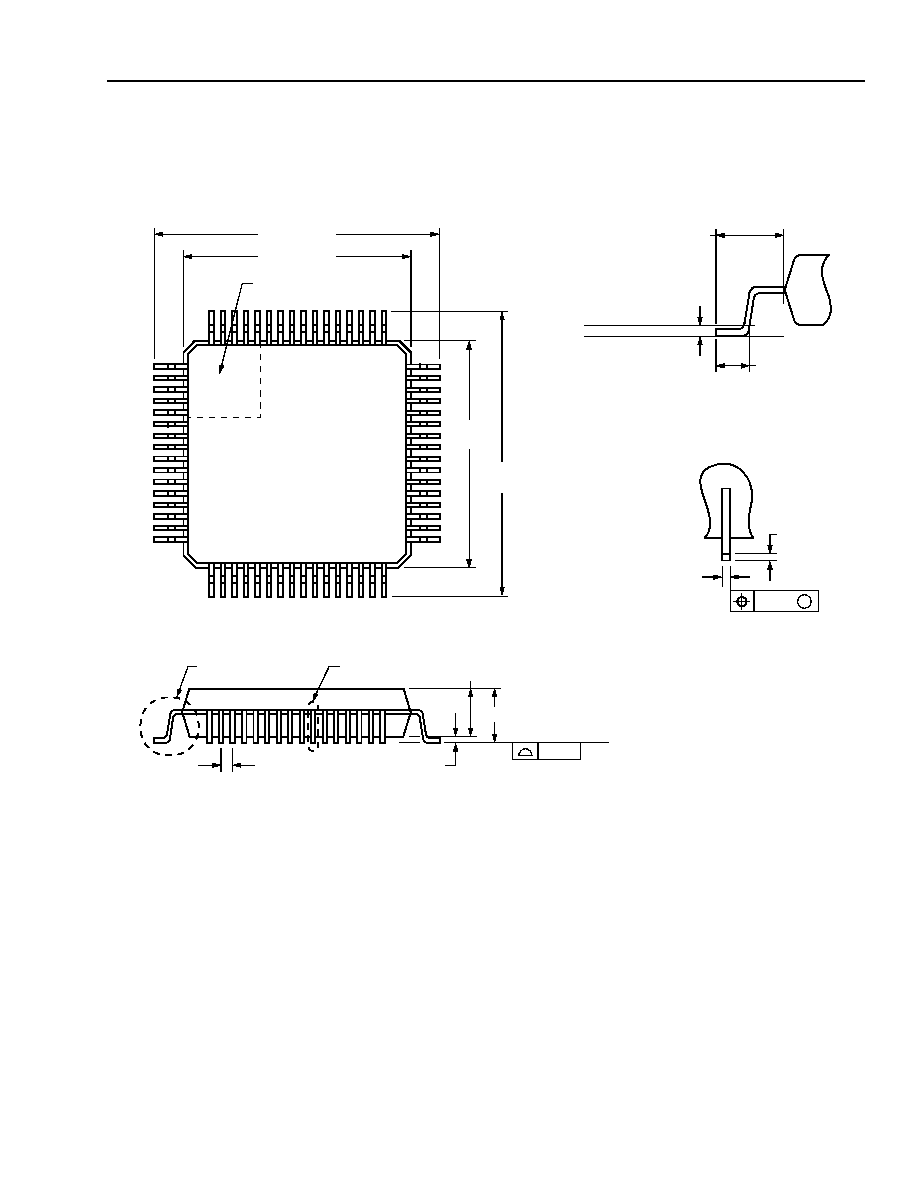
19
Lucent Technologies Inc.
Preliminary Data Sheet
LU5X31F
August 2000
Gigabit Ethernet Transceiver
Outline Diagrams
64-Pin MQFP
Dimensions are in millimeters.
33
48
14.00
±
0.20
17.20
±
0.25
DETAIL A
DETAIL B
3.00 MAX
0.80 TYP
SEATING PLANE
0.10
2.55/2.75
0.25 MAX
1
16
49
64
PIN #1 IDENTIFIER ZONE
17.20
±
0.25
14.00
±
0.20
32
17
0.30/0.45
0.16
M
0.13/0.23
DETAIL B
0.25
0.73/1.03
1.60 REF
GAGE PLANE
SEATING PLANE
DETAIL A
5-5205(F)
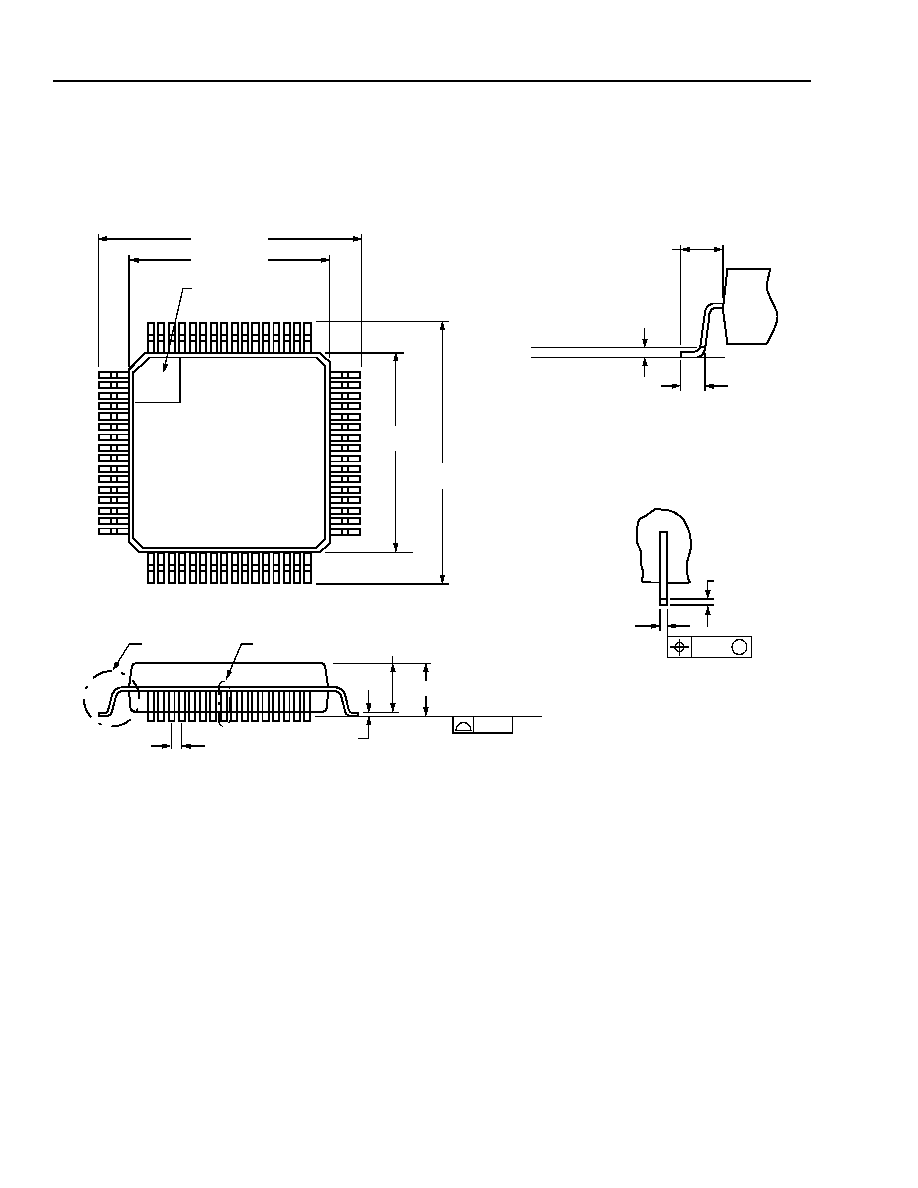
20
Lucent Technologies Inc.
LU5X31F
Preliminary Data Sheet
Gigabit Ethernet Transceiver
August 2000
Outline Diagrams
(continued)
64-Pin TQFP
Dimensions are in millimeters.
DETAIL A
0.50 TYP
1.60 MAX
SEATING PLANE
0.08
DETAIL B
0.05/0.15
1.40
±
0.05
10.00
±
0.20
12.00
±
0.20
1
64
49
16
17
32
48
33
10.00
±
0.20
12.00
±
0.20
PIN #1
IDENTIFIER ZONE
DETAIL A
0.45/0.75
GAGE PLANE
SEATING PLANE
1.00 REF
0.25
DETAIL B
0.19/0.27
0.08
M
0.106/0.200
5-3080(F)

21
Lucent Technologies Inc.
Preliminary Data Sheet
LU5X31F
August 2000
Gigabit Ethernet Transceiver
Ordering Information
Device Code
Comcode
Package
Temperature
LU5X31F
108497843
64-pin MQFP
0 ∞C--70 ∞C
LU5X31F
108831660
64-pin TQFP
0 ∞C--70 ∞C

For additional information, contact your Microelectronics Group Account Manager or the following:
INTERNET:
http://www.lucent.com/micro
E-MAIL:
docmaster@micro.lucent.com
N. AMERICA:
Microelectronics Group, Lucent Technologies Inc., 555 Union Boulevard, Room 30L-15P-BA, Allentown, PA 18109-3286
1-800-372-2447, FAX 610-712-4106 (In CANADA: 1-800-553-2448, FAX 610-712-4106)
ASIA PACIFIC: Microelectronics Group, Lucent Technologies Singapore Pte. Ltd., 77 Science Park Drive, #03-18 Cintech III, Singapore 118256
Tel. (65) 778 8833, FAX (65) 777 7495
CHINA:
Microelectronics Group, Lucent Technologies (China) Co., Ltd., A-F2, 23/F, Zao Fong Universe Building, 1800 Zhong Shan Xi Road, Shanghai
200233 P. R. China Tel. (86) 21 6440 0468, ext. 325, FAX (86) 21 6440 0652
JAPAN:
Microelectronics Group, Lucent Technologies Japan Ltd., 7-18, Higashi-Gotanda 2-chome, Shinagawa-ku, Tokyo 141, Japan
Tel. (81) 3 5421 1600, FAX (81) 3 5421 1700
EUROPE:
Data Requests: MICROELECTRONICS GROUP DATALINE: Tel. (44) 7000 582 368, FAX (44) 1189 328 148
Technical Inquiries: GERMANY: (49) 89 95086 0 (Munich), UNITED KINGDOM: (44) 1344 865 900 (Ascot),
FRANCE: (33) 1 40 83 68 00 (Paris), SWEDEN: (46) 8 594 607 00 (Stockholm), FINLAND: (358) 9 4354 2800 (Helsinki),
ITALY: (39) 02 6608131 (Milan), SPAIN: (34) 1 807 1441 (Madrid)
Lucent Technologies Inc. reserves the right to make changes to the product(s) or information contained herein without notice. No liability is assumed as a result of their use or application. No
rights under any patent accompany the sale of any such product(s) or information.
Copyright © 2000 Lucent Technologies Inc.
All Rights Reserved
August 2000
DS00-387LAN (Replaces DS00-350LAN)
LU5X31F
Preliminary Data Sheet
Gigabit Ethernet Transceiver
August 2000





















